Photo by Rosie Kerr on Unsplash
When the industry you love doesn’t love your gender back:
Caldecott Award by the numbers
by Christine Taylor-Butler
Starting March 1st, we’re celebrating Women’s History month with 31 days of posts focused on improving the climate for social and gender equality in the children’s and teens’ industry. Join in the conversation here or Twitter #kidlitwomen and access all the #KidlitWomen posts this month on our FaceBook page.
One note: On Twitter I erroneously stated that in 2018 no women were chosen. In fact, Thi Bui was given an honor award. She is a women of Vietnamese descent and joins a rare group of women receiving recognition.
In January 2018, a group of editors, authors and illustrators gathered to discuss barriers women face in the children’s literature industry. The participants included both men and women. It was an “unworkshop” white space which meant attendance was based on interest and was part of a wider set of ongoing discussions on craft and career advancement occurring over the weekend. The session was lively, often heated, and opened a lot of raw wounds. The session created a sense of urgency for us to look at the historical and current roles women play in the industry and how, in some ways, our contributions are overlooked or marginalized. The discussions spanned from lack of opportunities, lack of marketing exposure, to exclusion from panels at major venues. We covered ageism, the impact of the #MeToo movement on revealing the dark underbelly of our own industry. It also revealed that some of our peers are thinking of leaving the field. We’re tired and sometimes demoralized by the constant upward struggle. While the normal rules of the retreat dictate that “what gets said there, stays there,” in the end, the decision was made to go public with our stories and concerns using Women’s Month (March) as a launching point.
It should be noted, the every single person in the room was commercially published or actively employed in the industry. There were several hundred years of cumulative experience sharing their journeys. After a while it became clear that our personal experiences shared a common thread. We work in an industry that doesn’t always love us back. And has hard as it is for anyone to thrive, in some subsets it is particularly hard for women.
Being a math nerd, I took on the task to look at quantitative data. Numbers don’t tell the entire story, but they do point to patterns. There is a lot to crunch and not everything we need to examine is readily available. So we’ll be working with university researchers to help drill down more information about gender inequity from a number of different resources including but not restricted to compensation, marketing, awards, and even job placement.
But for this launch, one set of data points I examined stood out – the dearth of awards for women illustrators is glaring. Numbers don’t lie. Awards committees favor male illustrators over females. In time I’ll examine whether the same is true for acquisitions at publishing houses as well. But it’s often clear that awards pave the way for more contracts and higher advances.
NOTE: I am not an artist (although I have an Art degree). But as bad as things are for authors, these numbers reveal they are much worse for my “sisters.”
The Caldecott Award:
Established in 1938 the Caldecott Award is awarded to the most distinguished American picture book for children. It was created to honor artists who were otherwise unrecognized among other award categories. But apparently the work of women, particularly in the last few decades has not merited attention of the ever changing committees. Not even those with degrees and formal art training.
The numbers don’t lie: Since inception, the committee has bestowed 81 medals and 261 honor books. Based on the results, the odds seem ever in a man’s favor:
THE WINNERS by percentage.
54 Medals for men (67%)
21 medals for women (26%)
6 medals for illustrator pairs (often husband and wife) (7%)
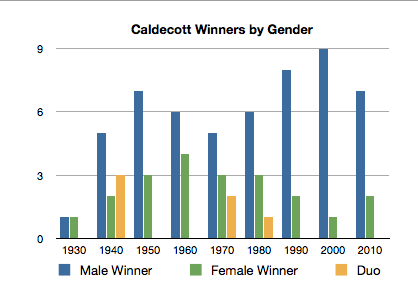
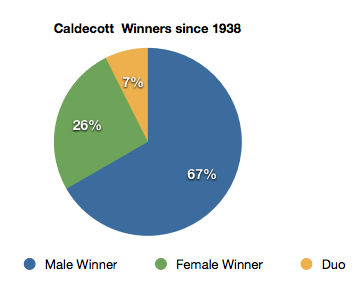
Please note the bar graph charts total winners per “decade”.
APPALLED? It gets worse.
- Women received solo medals ten (10) times in the first thirty-one years — 1938 to 1969.
- It took 48 additional years — from 1970 to 2018 —, for the eleven (11) additional medals to be awarded to women.
- Of 8 illustrators receiving multiple medals, only 3 were women:
Brown, Cooney and Hogrogian received a total of 7 of the 21 medals awarded to solo women illustrators.
- Therefore 17 solo women received a total of 21 awards in 81 years, most before 1970.
- Only one additional woman received a second award, Diane Dillon who won in consecutive years (1976, 1977) paired with her husband Leo Dillon (orange section). She is not included in the 21 awards noted in the green section above.
- In addition, of the 18 medals given out to repeat winners of all gender, four (4) men took home half (9) of those medals. (Wiesner, Van Allsburg, McCloskey and Raschka)
The numbers are only marginally better when we get to the honor category:
THE HONOR BOOKS by percentage.
159 Honors for men (61%)
97 Honors for women (37%)
5 Honors for pairs/duos (2%)
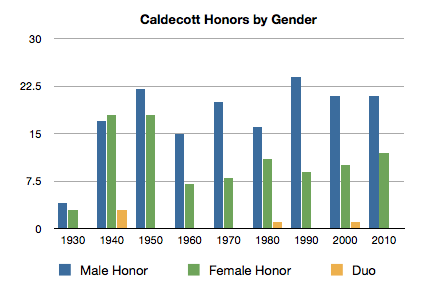
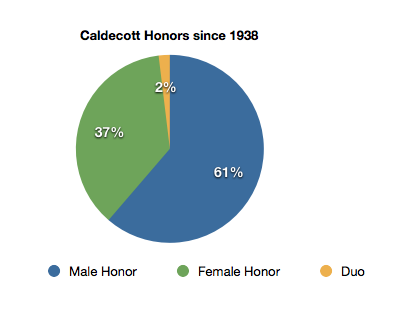
When looking at patterns, illustrators winning one or more honor awards were more likely to win a medal afterwards, with most being men. 37 male medalists took home an additional 65 honor books (some in the same year as their medal award). 7 women solo medalists took home 20 honor books with the most being Brown (6) and Ets (5) and Schart Hyman (3). So the total number of honor books actually reflects a much lower total of actual individuals. In fairness, a lot of males who got honors never took home the medal. But their numbers were represented far in excess of women in the pool.
EVEN WORSE: No Room At The Table?
In fifteen (15) of the award’s announcement years not a single women was named for a medal or honor. Women were shut out for four (4) years prior to 1970. They were shut out for eleven (11) years after 1970.
And what’s missing entirely? Women of color. With the exception of one illustrator born in Mexico (ethnicity not specified) and paired with her white husband in 1949, all remaining women winning the top medal have been white.
There is an old saying: “You get what you measure.” Publishers tend to read trends and acquire illustrators accordingly. I’ve heard stories of women illustrators who can’t even get a second contract. Even those that get an honor award.
ESSENTIAL QUESTION:
Women across the country are producing beautiful artwork. So is this an issue of lack of visibility to committees from publishers? Do publishers cherry pick who to send based on trends? Are committees swayed by marketing and favor those with “buzz.” Or is this a matter of not hiring enough talented female artists to work on books that might be awards contenders. Is there a built-in bias in our industry that favors men over women content creators?
You do the math.
NEXT BLOG:
The statistic that made me cry and kept me up at night. How the Coretta Scott King Award utterly fails Black women illustrators as the “men-only” bus rolls by.
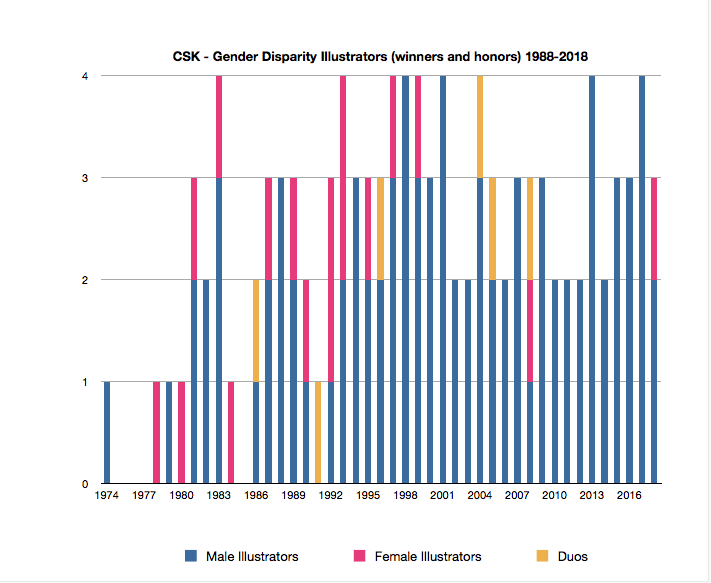
You can find out more at: #kidlitwomen

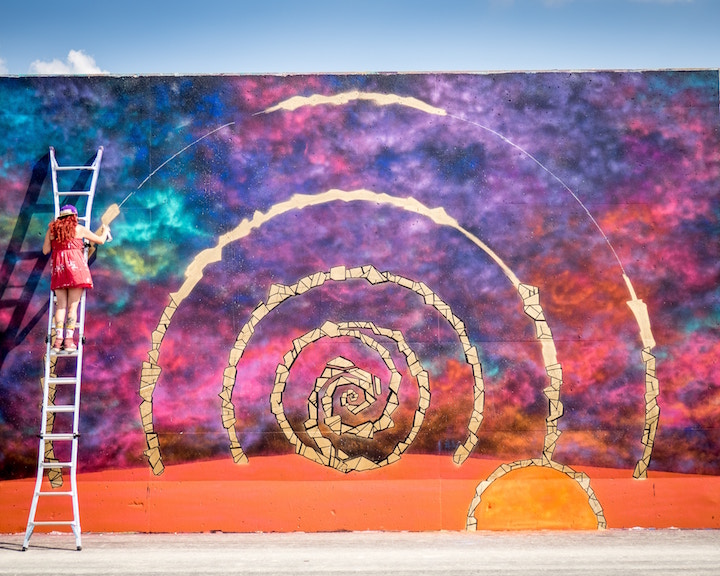

Thank you Christine for doing this startling math. I cry with you!
Wow! Very interesting. And people keep asking why we still need organizations like the NAACP.
Thanks, Christine, for all of your work! The graphs and pie charts really help to underscore the gender inequity regarding the Caldecott.
Splendid work, Christine. You confirmed what I’ve long suspected, but never checked up on to confirm.
I’m amazed that this post hasn’t had any comments yet, but allow me to say THANK YOU, Christine, for taking the time to compile this data. I hope beyond hope that this is the beginning of big changes.
Hi Julie. I completely missed that comments were set for moderation because of overseas spam that sometimes creeps into WP posts. I made sure everything is getting approved several times a day!
Thank you, Christine, for the eye-opener. One thing I’m curious about is what prcentage of PBs published have women illustrators and what percentage men.
So glad you are shining this spotlight. I can’t wait to read more!! #kidlitwomen
I wonder if the makeup of the committees make any difference? And it is kinda amazing how this follows the biases of our country in general.
aint most librarians chicks?
This is so infuriating and sad. I’m grateful for the work you put into looking at this data. Thank you.
I hesitate to “Like” this. I love that you did the research, and that you’re pointing out the imbalance, but I can’t like that the drastic inequality exists. Thank you for doing this, Christine!
Your point stands, but should it be 23 winning books by women (not counting couples)? http://www.ala.org/alsc/awardsgrants/bookmedia/caldecottmedal/caldecottwinners/caldecottmedal
Thanks, I’d missed one person so I’ll make sure the numbers reflect that!
One thing missing in the stats is this: How many men vs. women have been illustrators over the years? Without knowing this the percentages don’t mean much.
Actually – that’s incorrect. Those numbers will be coming in the future, however – if one assumed that men were employed at the same percentages as they win awards, the problem would still exist. It would point to women being underemployed and undervalued in the field. I help organize an annual event and our numbers track with those of SCBWi – a large majority of children’s content creators are female. So the problem is systemic.
I do believe the problem is not just at the awards level, but goes as far back as how art is assigned to illustrators at acquisition.
Perhaps what needs to happen is publishers need to reveal their gender breakdown in terms of annual contracts for illustration. And ALA committee discussions need to be open to the public as are the Notable discussions.
But is it the publishers responsible for underemploying and undervaluing the women, or does it go much deeper. The background in which one is raised can create a major influence on ones life, and being raised in a background where women are discouraged from creativity could prevent the women from developing an interest in the first place. I tend to see women as being capable of just as much creativity (if not more) than men though, so I feel that the issue lays more on the nurture side rather than the nature side in this case, but to find out where the disconnect is… I wouldn’t even know where to start.
I can say that women illustrators that I know who do beautiful work still struggle to find assignments (mostly a choice of Art Directors). All are classically trained in multiple styles. I’m an oxymoron. On top of my Engineering degree I have a separate Art & Design degree so I tend to look at work with a different lens. And it’s clear, talented women tend to be overlooked for both jobs and awards. I don’t think it’s a creativity issue. I think it’s a bias issue. Time will tell, though. I have more digging to do.
So well done, Christine!!! Perfect way to launch the month. Delighted to be catching up at last.
Thanks Dana. It’s been a good conversation in the industry. And timely.
There could be a number of causes that lead to this outcome. Like noted, it could be a bias of the people doing the ceremony, or it could just be that women don’t get enough jobs for this kind of award. Now, if it’s the latter, is it because of lack of interest or because of discrimination. Or is it because of lack of interest due to discouragement growing up. The outcome is clear, but the blame is currently almost impossible to place.
There are no easy answers. This is an issue that has been discussed quite a bit with little action taken in the past. But today’s environment is leading to heightened awareness. First, the industry is heavily populated with women. In early discussions about #kidlitwomen, there was a lot of anecdotal information about how women gatekeepers (some, not all) tend to fawn over the men in the industry but walk past or otherwise not engage or pay attention to the women. So that’s a problem. Because “sales” then drives publishers to publish more of what is valued.
But there is also an issue of whether publishers give book projects more often to male illustrators that have awards potential in terms of topics. I’ve been in the industry for almost 2 decades now and it does appear as if there is still a trend to think of men as “breadwinners” and women as “hobbyists” in the field.
In this case I’m concerned about makeup of committees and why there is a “trend” to favor works by a specific gender. There is more work to do to find the underlying cause.
But change happens only when we insist on it. Maybe this is a start. It certainly got a lot of attention.